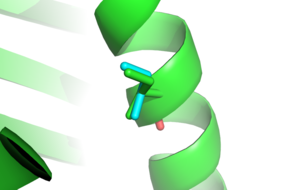Task 9: Structure-based mutation analysis
<css> table.colBasic2 { margin-left: auto; margin-right: auto; border: 1px solid black; border-collapse:collapse; width: 40%; }
.colBasic2 th,td { padding: 3px; border: 1px solid black; }
.colBasic2 td { text-align:left; }
/* for orange try #ff7f00 and #ffaa56 for blue try #005fbf and #aad4ff
maria's style blue: #adceff grey: #efefef
- /
.colBasic2 tr th { background-color:#efefef; color: black;} .colBasic2 tr:first-child th { background-color:#adceff; color:black;} </css>
Lab_Journal_Hemochromatosis_Task9
Contents
Structure Selection
| PDB ID | Res [A] | R-value (obs) | pH | missing residues | coverage |
|---|---|---|---|---|---|
| 1A6Z | 2.60 | 2.33 | 6.5 | 1-3 | 83.4% |
| 1DE4 | 2.80 | 2.31 | 8.0 | 1-3 | 83.4% |
From the two available structures, we chose 1A6Z, because it has a slightly higher resolution and a nearly identical resolution compared to 1DE4. On the downside, 1A6Z was resolved at a pH value of 6.5, which is more distant to the physiological pH than the resolution pH of 1DE4. 1A6Z was chosen nevertheless, because it was used in all previous tasks, in order to keep consistency.
Mutations
| Mutation | Disease causing ? |
|---|---|
| Val53Met | Yes |
| His63Asp | Yes |
| Met97Ile | No |
| Thr217Ile | No |
| Cys282Tyr | Yes |
<figtable id="mut_overview">
</figtable>
Structure Mutation using SCWRL
Val53Met
<figtable id="53_mut">
</figtable> Figure 2 shows that the mutation to Methionin does not change the polar contacts of the residue. But Methionin extends further into the binding pocket than Valin, which might disturb the structure of the binding pocket and inhibit the binding process.
His63Asp
<figtable id="63_mut">
Regarding the polar contacts of residue 63, there is no change, because both variants do not exhibit polar interactions (Figure 3). Also, the mutation lies in a loop region and does not disturb an ordered secondary structure. But nevertheless, the mutation is disease causing, which might be due to the fact that the loop where it is located is still part of the binding interface to ferritin and that the change from an aromatic, mainly uncharged residue to a negatively charged residue disturbs this interface.
Met97Ile
<figtable id="97_mut">
Both variants show the same polar contacts, which are only the intra-backbone hydrogen bonds that stabilize the alpha helix (Figure 4). The isoleucin is slightly smaller than methione, but the residue stays uncharged and nonpolar and thus, although it is located directly at the binding interface to ferritin, the mutatiion is neutral.
T217I
<figtable id="217_mut">
While the change from a polar to a non-polar side chain reduces the number of hydrogen bonds at this loop and thus the stability of the loop (Figure 5), it is not enough to affect the function of the protein, because the loop is not near a binding interface or an essential structural part.
C282Y
<figtable id="282_mut">
Although for this mutation, the polar contacts to the neighbouring beta sheet remain unchanged (Figure 6), it is evident why this mutation is the major cause for hemochromatosis. The replacement of cysteine with tyrosine causes a break of the disulfide bond that connects the two beta sheets of the Ig c1-set domain. Consequently, the structure of this domain is destabilized, which probably inhibits the formation of the HFE,ferritin,beta-micorglobulin complex. It is also noteworthy, that scwrl does not change the conformation of the cysteine binding partner, resulting in a clash of tyrosine and cysteine.
Comparison of SCWRL and FoldX
<figtable id="fx_scwrl" style="border-width: 0px">
Val53Met
His63Asp
Met97Ile
Thr217Ile
Cys282Tyr
Minimisation
| Method | Mutation | Iter. 1 | Iter. 2 | Iter. 3 | Iter. 4 | Iter. 5 |
|---|---|---|---|---|---|---|
| WT | - | -3724.15 | -5003.51 | -5118.38 | -5198.32 | -5301.44 |
| scwrl | V53M | -5022.73 | -5295.74 | -5154.72 | -5272.51 | -5260.4 |
| H63D | -4940.57 | -5212.88 | -5084.45 | -5190.74 | -5189.68 | |
| M97I | -5025.31 | -5291.5 | -5146.59 | -5247.72 | -5246.2 | |
| T217I | -5037.72 | -5307.97 | -5171.54 | -5277.0 | -5269.32 | |
| C282Y | -2596.78 | -5107.77 | -5037.12 | -5159.07 | -5191.73 | |
| foldx | V53M | -5323.9 | -5544.42 | -5450.03 | -5377.19 | -5436.94 |
| H63D | -5284.49 | -5493.82 | -5437.69 | -5364.69 | -5454.72 | |
| M97I | -5264.67 | -5482.17 | -5405.78 | -5343.15 | -5255.85 | |
| T217I | -5275.89 | -5492.39 | -5416.59 | -5343.98 | -5431.55 | |
| C282Y | -3376.95 | -5217.05 | -5194.04 | -5231.15 | -5290.49 |





















